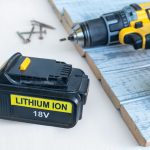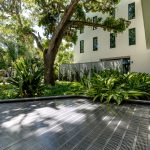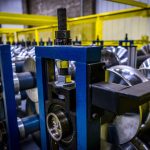Metal roofing systems are designed to shed moisture off buildings and they are the first line of defense against moisture from rain or snow. All metal roofing systems benefit from underlayments.
Comparing the three major metal roof underlayment categories

Photo courtesy of SOPREMA Inc.
The underlayment is the layer of material laid on the roof prior to the metal roofing installation, separating the roofing material from the roof deck. Underlayments protect the roof deck and interior structure from chemicals and resins, and provide critical secondary protection against moisture infiltration. A properly designed and installed underlayment prevents moisture from seeping through the roof deck into the structure below.
This article compares the attributes of three of the most commonly used underlayments used for metal roofs today:
• asphalt-saturated felt
• rubberized asphalt (also known as SBS modified underlayment, self-stick)
• non-bitumen synthetic
Asphalt-Saturated Felt
One of the most common types of underlayment used is black, asphalt-saturated felt paper, also called roofing tar paper. It can be made from either organic or fiberglass substrate, although the organic is much more common. It’s called organic underlayment because it has a cellulose base. Felt paper was widely used in the mid- to late-1900s as the preferred underlayment choice because it was cost effective, and highly dependable in deflecting leaks and internal ceiling protection. However, felt is slowly being phased out due to new and improved product developments (synthetics), but still used today in steep-slope and shingle applications.
According to Bob Griffiths, product management, Firestone Building Products, Nashville asphalt-saturated felt underlayment:
• Is available in 15- and 30-pound thickness.
• Is water-resistant, but not waterproof.
• Has a perm rating of about 5.
• 30-pound felt is more resistant to damage.
• Generally mechanically attached.
• Typically absorbs water easily but fails sooner than the other two types.

Photo courtesy of CertainTeed

Photo courtesy of CertainTeed
“Asphalt-saturated felt has certain disadvantages, including the fact that it may need to be doubled-up in lower-slope applications to prevent leakage through the material,” says Chris Ray, national sales manager at Levis Building Components, Leola, Pa. “It is subject to loss of volatile content, leading to material breakdown. It is also not greatly resistant to UV breakdown, and is also subject to installation damage as it is not the most resilient of materials.”
Bailey Reeves, product manager, CertainTeed, Malvern, Pa., says one of asphalt-saturated felt’s biggest advantages is its lower cost. “[But its cons are] it’s heavier, [has] less squares per roll, wrinkles when wet, [has] poor fastener pull-through and [is] less tear-resistant. While metal roofing often comes with solar-reflective paint (cool roof) options, metal panels tend to get hot where the underside comes into direct contact with the underlayment. As such, CertainTeed does not allow asphalt-saturated felt under any of its metal products. A synthetic underlayment with higher heat tolerance is typically best for metal roofing.”
Benjamin Runyan, product manager, SBS Roof Systems & Accessories at SOPREMA Inc., Wadsworth, Ohio, agrees that felt underlayments are inexpensive, and, “Are more widely seen in big box stores for smaller residential projects typically seen in shingle applications. The typical UV exposure is not typically given as these membranes should be covered immediately to not be damaged by environmental conditions. Like synthetic underlayments, felt underlayments can also require certain applications like cap nail fastening which can pose a threat to the watertightness of the underlayment material. [They] have the potential to curl and wrinkle if subjected to harsh environmental conditions for longer periods of time. These underlayments have less tear resistance against foot traffic, thus compromising the performance of the felt underlayment.”
Rubberized Asphalt
Various types of rubber-like materials called rubberized asphalt (often called SBS modified underlayment) are used as underlayments. Asphalt can be polymer-modified with bitumen (a viscous mixture of hydrocarbons), which gives it rubber- or plastic-like properties. Ray says these polymers enhance its resistance to damage and deterioration. Rubberized asphalt underlayment is applied in large panels that are bonded together or heat-fused into one seamless membrane.

Photo courtesy of MFM Building Products
Rubberized asphalt has adhesive on one side, which is protected by a peel-off membrane, making it self-adhering. Its rubber-like qualities prompt selfsealing, meaning that it forms and seals well around fasteners, staples, nails roof penetrations and unusual shapes to aid waterproofing.
Ray says rubberized asphalt underlayment is heavier (48 mil+), can be difficult to use and applying it can be labor intensive—a reason it is not typically used in whole-roof applications. He contends since it is difficult to handle, it is not always preferred for high-slope applications. However, “[Rubberized asphalt underlayment] can provide labor cost savings due to the speed and ease of installing a self-adhered underlayment compared to an underlayment that requires a mechanically fastened installation,” Runyan says. “These rolls are thicker than synthetics or felts, and that assists in the longevity of the installed underlayment. However, the downside to having a thicker underlayment is that they cover less square feet per roll, requiring more rolls to complete a larger project.”
“Rubberized asphalt underlayments work the best over the other two in terms of continued waterproofing protection should the main roof system become damaged,” says David Delcoma, product marketing manager, MFM Building Products, Coshocton, Ohio. “They also protect the structure from moisture before the finished roofing is installed. Granulated-surfaced underlayments are not recommended for use under metal roofing because the granules can scratch the underside of the metal panels.”
Inherently flexible, it is ideal for climates that experience both extremely hot and cold weather. Consider heat gain. “The key to using rubberized asphalt underlayments under metal roofing is the adhesive system must be rated for high-temperature applications (225 F or above) due to high heat generated under the metal panels,” Delcoma says. “If the self-adhered underlayment does not use a high-temperature adhesive, the heat will liquefy the mastic and it can run down the side walls of the structure. Copper roofing typically needs a high temperature adhesive in excess of 250 F, which not many companies offer.”

Photo courtesy of CertainTeed
For successful self-adhered underlayment installation, temperatures must be considered. “Warm temperatures coupled with dry substrates enhance the underlayment adhesion process,”
Griffiths says. “Cold temperatures coupled with wet substrates will not only lessen but may even prevent adhesion. For self-adhered products, it’s recommended that the temperature be 40 F and rising for the product to work best. At colder temperatures, material becomes less flexible and won’t stick well. Hotter temperatures can be a problem as well. If it’s too hot and your installing as sticky underlayment is becomes almost impossible to get the sheet installed flat with no creases.”

Photo courtesy of SOPREMA Inc.
Because underlayments may be exposed in metal roofing applications, for a period of over 60 or even 90 days, the UV exposure rating must be considered. “UV will eventually break down the top film surface causing it to easily tear from foot traffic and make it more susceptible to water leaks,” Delcoma says. Runyan says rubberized asphalt can typically guard against UV exposure for 90 to 180 days, and believes this puts it at the top of the underlayment class for this category.
Non-Bitumen Synthetic
Different types of synthetic underlayment have been around since the early 2000s and they have become arguably the most commonly used metal roof underlayment today. Most synthetics are woven or spun from either polyethylene or polypropylene. While the ingredients are similar, the manufacturing process and thickness of each underlayment type can be fine-tuned to produce different properties, such as exposure time and walkability.
“Synthetics are lighter, easier to apply and often provide greater levels of skid resistance,” Ray says. “Many of the roofers I have spoken with will choose an underlayment chiefly due to its ability to reduce slippage. They are resistant to fungal growth, don’t absorb moisture, are highly resistant to UV penetration and can stay exposed for greater periods of time, sometimes up to six months. In most instances, the synthetic material is the go-to for most slopes and, depending on the application, can be used in conjunction with the rubberized asphalt product.”

Photo courtesy of MFM Building Products
Reeves says synthetic’s advantages include their lightweight, maximum squares per roll (~10 squares/roll), dimensionally stable properties, strong fastener pull through and maximum tear resistance. He says their disadvantages are they are more expensive, can’t seal around fasteners and they can’t provide ice dam protection.
“A benefit to using synthetic underlayment is that they can cover more area per square foot,” Runyan says. “Another benefit is that these underlayments can contain an anti-slip feature that increases safety on steeper slope applications with foot traffic. [However,] synthetic underlayments require cap nail fastening, which increases the labor cost and has a greater chance of water intrusion if the waterproofing cap is damaged if installed improperly. These underlayments can come in self-adhered versions. These membranes are generally thin and do not provide good puncture resistance to guard against foot traffic and the installed metal roof above.”
Reeves contends asphalt-saturated felt underlayments can wrinkle when wet and “telegraph” those wrinkles through to the shingles or panels that would be applied over it. “A synthetic underlayment eliminates this problem and often comes with special top surface treatments that offer excellent slip resistance, even when wet. If you’re installing in a rain-prone area, a synthetic underlayment is often the best option for contractor safety.”
In terms of quality, Ray says synthetics, due to their material and content, as well as manufacturing processes, are more likely to meet described material profiles. “As such, they can be counted on to perform as they are described. Many of the synthetics are rated according to warranty categories, with 25-year, 50-year and lifetime warranties available, dependent upon parameters such as millage and slippage ratings.”





